Occurrence of polycyclic aromatic hydrocarbons in the estuarine sediments of the Taihu Lake and their associated toxic effects on aquatic organisms
2022-12-14TianSUNYanhuaWANGYanCHENMingliZHANGandXinggongKONG
Tian SUNYanhua WANG∗Yan CHENMingli ZHANG∗and Xinggong KONG
1School of Geography,Nanjing Normal University,Nanjing 210023(China)
2Jiangsu Center for Collaborative Innovation in Geographical Information Resource Development and Application,Nanjing 210023(China)
3KeyLaboratoryof Virtual Geographic Environment,Nanjing Normal University,Ministryof Education,Nanjing 210023(China)
ABSTRACT Polycyclic aromatic hydrocarbons(PAHs)are ubiquitous toxic organic pollutants in the natural environment that are strongly associated with socioeconomic activities.Exploring the distribution,sources,and ecological toxicity of PAHs is essential to abate their pollution and biological risks.The 16 priority PAHs in different lakeside city estuarine sediments in the northern Taihu Lake in China were determined using gas chromatography-mass spectrometry.Results showed that total concentrations of PAHs(ΣPAHs)ranged from 672.07 to 5 858.34 ng g−1,with a mean value of 2 121.37 ng g−1.High-molecular-weight PAHs(4–6 rings)were dominant,accounting for 85%of the ΣPAHs detected.Due to the barrier of gate/dam in the estuarine area,the concentrations of PAHs in the sediments were significantly different between the river mouth and lake side.Changes in total organic carbon(TOC)content and the spatial distribution of PAHs in the sediments were consistent.Sediment pollution assessment explored using the fuzzy evaluation model indicated 75%of slight PAH pollution.Some estuarine sediments(22%)concentrated in the east of the Wuli Lake in the Meiliang bay of the Taihu Lake were moderately or heavily polluted.The PAHs may lead to occasional detrimental biological consequences in the area.Diagnostic ratios and principal component analysis-multiple linear regression suggested vehicle emission and natural gas combustion as the primary PAH contributors(81%).
KeyWords:contamination source,ecological toxicity grade,fuzzy evaluation model,pollution risk assessment,principal component analysis-multiple linear regression,total 16 polycyclic aromatic hydrocarbons,toxic organic pollutant
INTRODUCTION
Over the past few decades,the environment in the Taihu Lake basin in China has been deteriorated as a result of intense human activity,especially along the lakeside,where human population concentrates(Li Yet al.,2020;Huanget al.,2020).A sharp increase in population and expansion of land-use including agriculture,industry,and tourism are generating elevated local emissions of contaminants,directly affecting the lake environment.Polycyclic aromatic hydrocarbons(PAHs)are one of the major pollutants and have become a focus of public concern in the Taihu Lake basin because of their high toxicity,persistence,and bioaccumulation in nature(Leiet al.,2016;Liet al.,2019).
Polycyclic aromatic hydrocarbons with strong carcinogenicity,mutagenicity,and teratogenicity-induced toxicity effects on food security and human health are mainly derived from combustion of various organic materials,such as exhaust emissionsviathe production and use of substances containing large amounts of petroleum hydrocarbons(Boldenet al.,2017;Hanet al.,2019).These compounds are also emitted from wood and grass burning(Li Q Yet al.,2020)and food processing(Stogiannidis and Laane,2015).Additionally,they have been detected in oil spills(Masihet al.,2012)during petroleum transportation and natural oil seeps(Pauliket al.,2016).Sediments serve as the ultimate destination of PAHs,where PAHs can easily combine with organic matter and are adsorbed by sediment particles due to their lipophilicity and hydrophobicity(Hadibarataet al.,2019).Therefore,PAH concentrations in the sediments potentially reflect the degree of regional pollution and biological safety to a certain extent.Moreover,PAHs also pose a long-term potential threat to the aquatic environment and organisms(Zhaoet al.,2017).Estuaries,as confluences of rivers and lakes,are rich in organic contaminants,such as PAHs,due to their special geographical location and unique hydrodynamic conditions(Uenoet al.,2002).Thus,the risk of PAH contamination in estuary sediments should not be overlooked.Many risk evaluation methods have been established,and yet there are some defects simultaneously accompaning these methods.For instance,sediment quality guidelines(Longet al.,1995),mean effect range-medianquotient(Long and MacDonald,1998),and toxic equivalent quantity(Nisbet and LaGoy,1992)all employ a simplified comparison with indicators or thresholds.The fuzziness of interaction among individual PAH is not taken into account,which makes the toxicity evaluation results equalized.However,random uncertainty exists in the actual evaluation process.To address this problem effectively,the fuzzy theory was introduced to evaluate and classify the pollution level of contaminants(Lourençoet al.,2010).Previous studies were proved to be available to resolve the fuzzy characteristics of contaminant pollution level with a gradual change from light to heavy based on membership functions(Tanet al.,2006;Yanget al.,2016).Therefore,it is necessary to establish a hierarchical structure for the fuzzy evaluation method which considers the weight values of individual PAH and their interactions,reflecting the ecological toxicity of PAHs in the sediments to aquatic organisms more scientifically compared to the existing methods.
MARERIALS AND METHODS
Studyarea and sample collection
The Taihu Lake(30◦55′40′′–31◦32′58′′N,119◦52′32′′–120◦36′10′′E)is the third largest freshwater lake in China,located in the Yangtze River Delta(Fig.1).The watershed covers an area of approximately 36 900 km2,with a population of more than 37 million,constituting 2.70% of the total population in China.More than 200 rivers flow in the Taihu Lake basin,and over 85%of them are connected to the lake,which receives large amounts of contaminantsviariverine runoff(Zhaoet al.,2017).
During the sampling campaign(March 2018),surface sediments(0–5 cm)were collected in 21 lakeside estuaries with a depth of<2 m in the Meiliang(ML)bay(M1–M13)and the Gonghu(GH)bay(G1–G8)in Wuxi City in the northern Taihu Lake(Fig.1)(Leiet al.,2016).The study area covers approximately 0.85%of the Taihu Lake basin(see more details in Table SI,see Supplementary Material for Table SI).Two sampling sites were set in an estuary section,site 1,located upstream near the estuary,and site 2,located in the estuary near the lake.Some sections lacked either site 1 or site 2.A total of 32 representative surface sediment samples were collected from the sites using a stainless steel grab.All samples were stored in labeled aluminum foil bags and stored at−20◦C for further analyses.
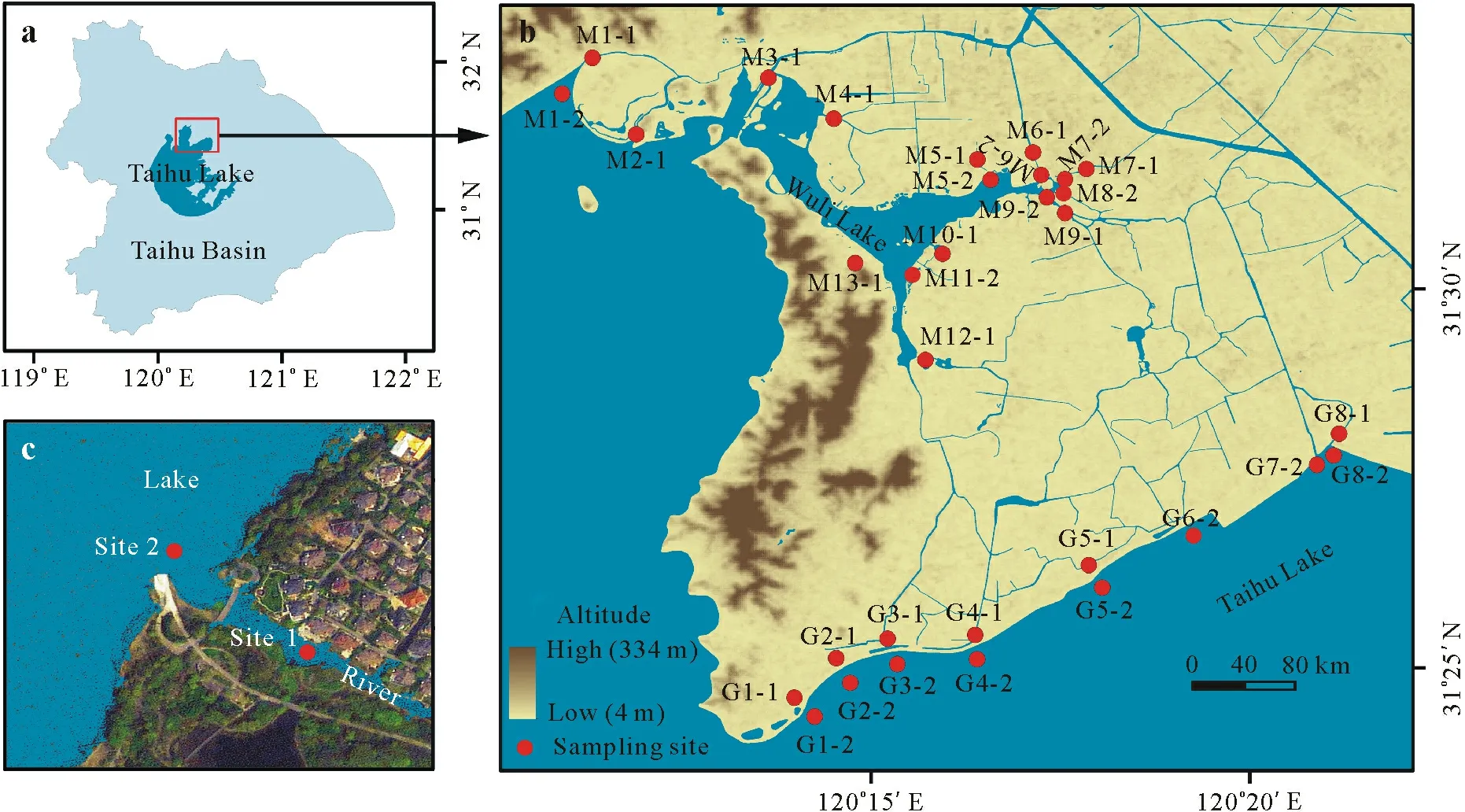
Fig.1 Study area in the Taihu Lake basin of China(a),estuary sections in the Meiliang bay(M1–M13)and the Gonghu bay(G1–G8)in the study area(b),and locations of two sampling sites in an estuary section(some sections lacked either site 1 or site 2)(c).
Sample preparation and instrument analysis
Gravel and animal and plant residues were removed from the freeze-dried samples.The samples were then ground and sieved through a 100-mesh sieve.Anhydrous sodium sulfate and silica gel,as the column sorbent materials,were activated at 450 and 180◦C for 4 and 6 h,respectively,and allowed to cool down to room temperature(25◦C).The cleanup column was prepared with 1 g of anhydrous sodium sulfate and a combination of silica(1.5 g)and anhydrous sodium sulfate(1 g).Homogenized sediment samples(2 g from each sample)were transferred into 34 mL extraction tanks for accelerated solvent extraction(ASE),and the cell was placed into the carousel of the ASE 350 system(Thermo Scientific,USA).The system was filled with a mixture ofn-hexane and dichloromethane(1:1,volume:volume)and run under the following operating conditions:heating for 5 min at an oven temperature of 100◦C and static extraction for 5 min at a pressure of 10 MPa.The extract was then purged from the sample cell using N2for 90 s.The extract was collected into a suitable vial and concentrated to 2 mL through a vacuum rotary evaporation process in a 40◦C water bath.The extract was then purified by passing through a prepared chromatography column.The extract was rinsed from the purification column using 15 mLn-hexane/dichloromethane mixture and 5 mLn-hexane,its volume was reduced to 0.5 mL with an evaporator,and it was then diluted to a final volume of 1 mL withn-hexane.
The 16 priority PAHs recommended by the United States Environmental Protection Agency were determined with a gas chromatography-mass spectrometer system(8860-5977 GC system,Agilent,USA)with a DB-5MS silica capillary column(film thickness,0.25µm;inner diameter,30 m×0.25 mm).High purity(99.999%)helium was used as a carrier gas at a flow rate of 1 mL min−1.Each sample was injected at a volume of 1 µL with the splitless injection method.The temperatures of the injector and detector were 250 and 280◦C,respectively.Initially,the oven temperature was 50◦C,holding for 1 min before being increased to 180◦C at 15◦C min−1,and then to 280◦C at 5◦C min−1,maintained for 5 min.The mass detector was operated at 70 eV,and the ion source temperature was 280◦C.The PAH concentrations were scanned in the full scan mode from 50 to 550 atomic mass unit for peak confirmation and classified according to retention time and mass-to-charge ratio(m/z)value.
All 16 priority PAHs were detected in the present study,including 2-ring naphthalene(Nap),3-ring acenaphthylene(Acy),acenaphthene(Ace),fluorene(Flu),phenanthrene(Phe),and anthracene(Ant),4-ring fluoranthene(Flua),pyrene(Pyr),benz(a)anthracene(BaA),and chrysene(Chry),5-ring benzo(k)fluoranthene(BkF),benzo(b)fluoranthene(BbF),benzo(a)pyrene(BaP),and dibenzo(a,h)anthracene(DahA),and 6-ring indeno(1,2,3-cd)pyrene(IcdP)and benzo(g,h,i)perylene(BghiP).Additionally,the total organic carbon(TOC)concentration in the freeze-dried samples was analyzed with a total organic carbon analyzer(TOC-L CPH,Shimazu,Japan).
Qualityassurance and qualitycontrol
All cleaned glassware was dried at 550◦C for 6 h.Method blanks,recoveries,and duplicate samples were used to ensure data reliability.The external standard method was used to quantify individual PAH compound by using a sevenpoint calibration curve(50,100,250,500,1 000,2 000,and 2 500 ng mL−1)with the coefficient of determination(R2)>0.996.The method blanks showed no detectable amounts of PAH contamination,and obtained concentrations were not corrected with recoveries.The relative standard deviations of the 16 PAHs in all duplicate samples were less than 10%.The method detection limit,recovery rate,andm/zvalue are shown in Table SII(see Supplementary Material for Table SII).The concentrations were reported on a dry weight sediment basis.
Then came the Devil once more, and put a different letter in his pocket, in which it was written that they were to put the Queen and her child to death
Fuzzymodel set
For fuzzy synthetic evaluation,15 types of PAHs(except BghiP)were selected as biological risk indicators to assess the environmental quality of the sediments.The classification of ecological toxicity degree for indicators was established on the basis of the Sediment Quality Standards(Kanget al.,2017)and Soil Environmental Quality Risk Control Standard for Soil Contamination of Development Land(MEE,2018).However,the sediment quality concerning BghiP was not considered in the present study due to the lack of standard of BghiP.According to the fuzzy matrix,a comprehensive evaluation system was established,with U(15 types of PAHs)taken as the evaluation factor set.Ecological toxicity of PAHs in the sediments was classified into five levels(Table SIII,see Supplementary Material for Table SIII):Class I(good condition with negligible ecological toxicity),Class II(clean condition with low ecological toxicity),Class III(slightly polluted with acceptable ecological toxicity),Class IV(moderately polluted with potential ecological toxicity),and Class V(heavily polluted with high ecological toxicity).Membership functions of PAHs to criteria at the five grades were established according to the trapezoidal algorithm(Yanget al.,2016).
Membership function of pollutantito Class I(j=1)was:

Membership function of pollutantito Classes II–IV(j=2–4)was:

Membership function of pollutantito Class V(j=5)was:

wherexiis the measured concentration for pollutanti,vijis the standard value of theith pollutant at thejth level,andrijis the membership degree of theith pollutant at thejth level,withrij∈[0,1].The smaller the membership degree,the better the environmental quality.According to the fuzzy relation between factor set U and evaluation set V,the fuzzy matrix(R)was obtained as follows:

Due to the differences in the contribution of each evaluation indicator to ecological toxicity,a different weight should be applied to each indicator.To address this problem,Nisbet and LaGoy(1992)introduced toxic equivalency factors,which could be used to determine PAH toxicity in sediments objectively and precisely.Then,a method of weighted stacking that combined entropy weight and toxicity coefficient was used to scale the synthetic effect of toxicity and PAH values as follows:
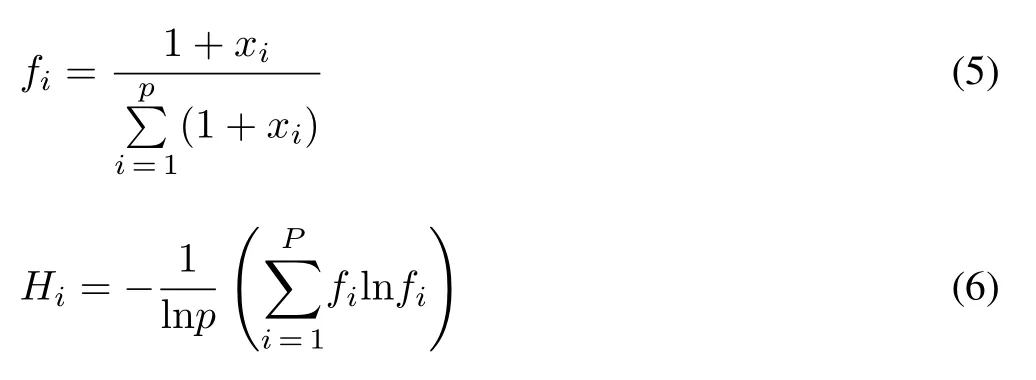
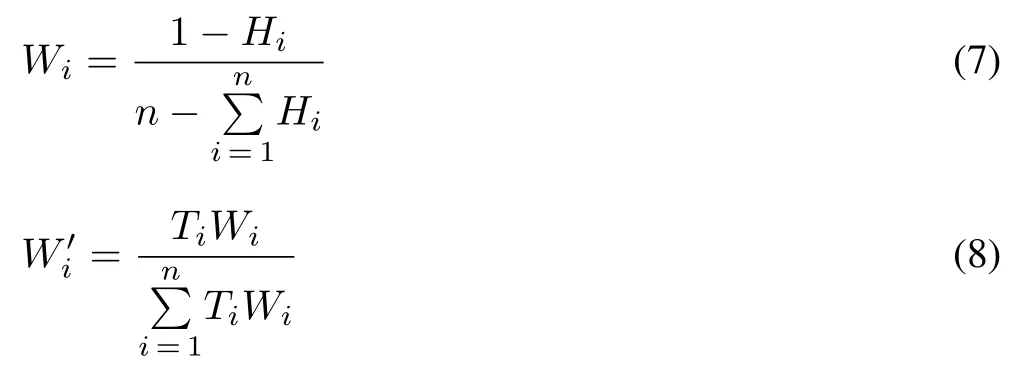
wherepis the number of samples,Wiis the weight for theith PAH using entropy method,W′iis the modified weight for theith PAH considering toxicity,andTi(Table SIV,see Supplementary Material for Table SIV)is the toxic coefficient for theith PAH(Nisbet and LaGoy,1992).The fuzzy synthetic matrix(B)can be obtained by multiplying the weight matrix(W)and the fuzzy matrix(R)asB=WR.The maximum membership principle was used to select the max(B),which was then utilized to identify the environmental quality class of sediments.
Statistical analysis
Statistical analysis was performed with SPSS 21.0(SPSS Inc.,USA).ArcGIS 10.0(ESRI,USA)was used to plot the map of sampling sites.Model designs of the fuzzy synthetic method were established using Matlab 7.0(Math-Works,USA).Diagnostic ratios were calculated to identify the potential sources of PAHs,and the principal component(PC)analysis(PCA)-multiple linear regression(MLR)(PCA-MLR)was employed to further study the quantitative assignment of PAH sources.The contribution of each sourcei(Contributioni)was assessed based on the coefficients of components in the MLR equation(Larsen and Baker,2003;Taoet al.,2019),which is expressed as follows:

whereBiis the regression coefficient of theith principal component.
RESULTS AND DISCUSSION
Occurrence of PAHs in estuarine sediments
Differences in PAH concentrations and compositions in the surface sediments of lakeside estuaries in the Taihu Lake are shown in Fig.2.The 16 PAHs were detected in all samples,with levels ranging between 672.07 and 5 858.34 ng g−1,with a mean value of 2 121.37 ng g−1.The highest PAH concentration was recorded at M9-1 in the ML bay,with a value of 5 858.34 ng g−1.Sediments ranked into four pollution levels on the basis of the concentrations of PAHs:low(<100 ng g−1),moderate(100–1 000 ng g−1),high(1 000–5 000 ng g−1),and severe(>5 000 ng g−1)(Baumardet al.,1998).Based on this classification,the region(as a whole)was heavily affected by PAH pollution.The PAHpollution in most samples(63%)was at a high level,and in some samples(9%)it reached the severe level.Compared with PAHs in the sediment samples of lakes worldwide(Table I),the PAH concentrations in sediments from lakes in China are generally low,whereas the concentrations of PAHs observed in this study were well above those reported from remote lakes in China.This was probably caused by the long contamination history and strength of PAHs(Leiet al.,2016;Liet al.,2019),as more PAHs were absorbed by sediments in the Taihu Lake as compared to those in lakes located in less developed areas of China,such as the Dianchi Lake(746–2 293 ng g−1)(Maet al.,2020),the Fuxian Lake(301.7–1 964.4 ng g−1)(Taoet al.,2019),and the Hanfeng Lake(22–1 324 ng g−1)(Caiet al.,2017)in Southwest China and the Yamzho Yumco Lake(6.52–57.97 ng g−1)(Wanget al.,2019)and the Qinghai Lake(11–279 ng g−1)(Wanget al.,2010)in Northwest China(Table I).The concentrations reported here were higher than those in sediments from the Taihu Lake reported by other researchers(Leiet al.,2016;Liet al.,2019).This discrepancy may be attributed to the fact that the estuaries are close to the main region of human economic activities.Rivers flowing through cities are more vulnerable to the impact of industries,agriculture,and residential activities,causing contaminants carried by rivers to deposit in estuaries.Therefore,proximity to commercial areas and weak hydrodynamics are important reasons for the enrichment of contaminants in estuaries.Although the Sediment-Dredging Project and the 11th/12th/13th Five-Year Plans for Water Pollution Control have been involved in the management of the Taihu Lake in recent years(Liu and Qiu,2007;Paerlet al.,2011;Leiet al.,2016),little effect has been observed in the control of PAHs in the sediments from tributary rivers,and further targeted governance measures are needed.
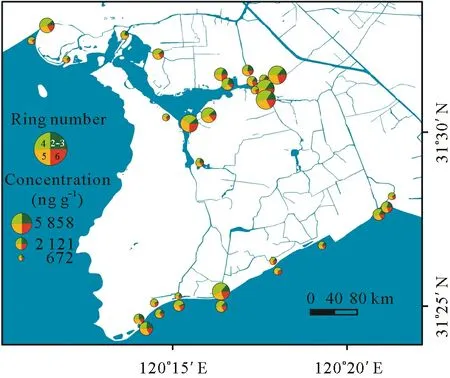
Fig.2 Concentrations of the total 16 priority polycyclic aromatic hydrocarbons(PAHs)and the relative percentages of PAHs with 2–6 rings,including 2-ring naphthalene,3-ring acenaphthylene,acenaphthene,fluorene,phenanthrene,and anthracene,4-ring fluoranthene,pyrene,benzo(a)anthracene,and chrysene,5-ring benzo(k)fluoranthene,benzo(b)fluoranthene,benzo(a)pyrene,and dibenzo(a,h)anthracene,and 6-ring indeno(1,2,3-cd)pyrene and benzo(g,h,i)perylene in the sediments from the Meiliang and Gonghu bays in northern Taihu lake,China.
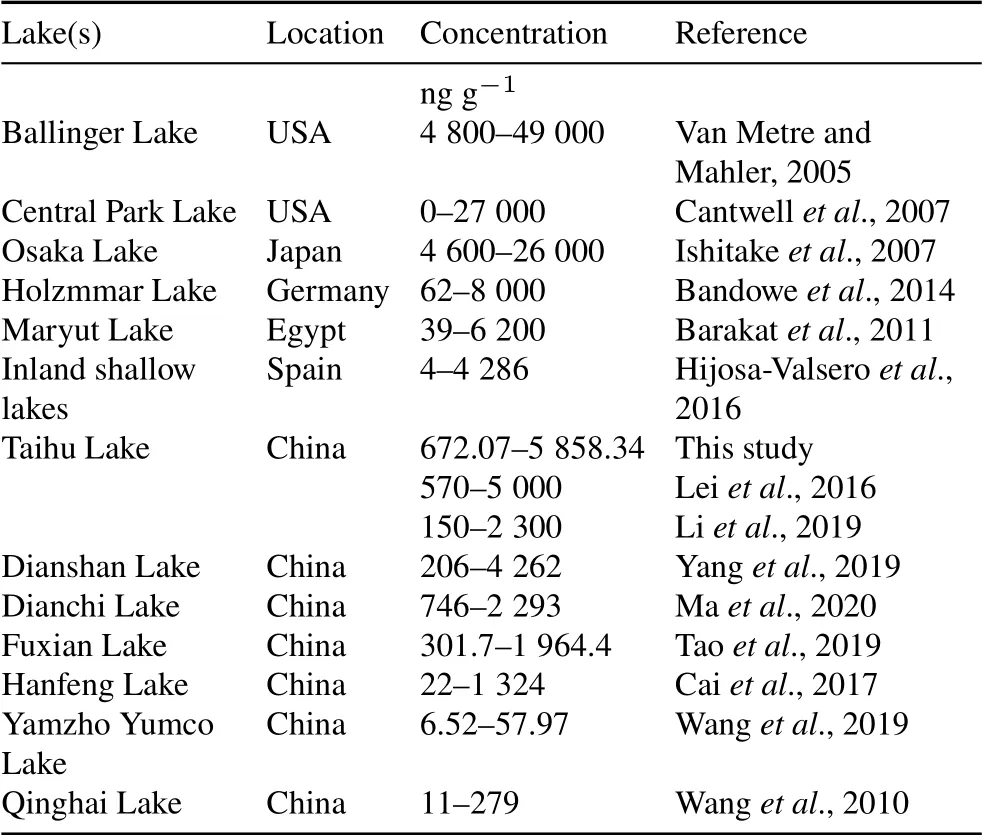
TABLE IComparison of polycyclic aromatic hydrocarbon concentrations in sediments from different lakes worldwide
Spatial distribution and regional comparison
The PAH concentrations showed a strong spatial distribution characteristic in the sediments(Fig.2).Overall,the PAH concentrations in the sediments of the ML bay(mean value:2 476.52 ng g−1)were higher than that of the GH bay(mean value:1 664.75 ng g−1).The high PAH levels were detected in samples collected from M7-1,M8-2,M9-1,M10-1,and M11-2,located in the east part of the Wuli Lake in the ML bay.Sampling sites in the ML bay are close to urban districts with a large area of impervious surface around them,resulting in the accumulation of contaminants generated by various industrial and residential activities in the sediments.Most of the sampling sites in this area are located along the Wuli Lake,harboring a dense river network,while the space with less water exchange is relatively enclosed.Thus,intense urban activities and closed water area may be the reason for the high PAH concentrations.Especially,sampling sites M7–M11,with high PAH concentrations,are adjacent to the residential area,indicating the substantial contribution of urban domestic sewage discharge and traffic pollution,as well as of domestic garbage dumping near the sampling sites.Conversely,sampling sites in the GH bay are located in suburbs where the government has built wetland parks for residents and tourists.Wetland parks play a key role in water purification.Plants absorb contaminants from the surface soil and transfer them out through regular lawn pruning or degrade them through microbial action of plant roots,resulting in low PAH levels in the sediments of theGH bay.Moreover,land areas along the shore of the GH bay are used for farming and cultivation of vegetables and fruits.Thus,agricultural production practices there probably contributed to the release of PAHs.
A gate or dam was built in most of the estuaries in the study area to control hydrological connectivity of the rivers and lakes,thus affecting the fate of contaminants in the aquatic environment.As for each estuary section,PAH concentration in the estuary and river sediments was significantly different,which was dramatically affected by the gate/dam(Fig.2).Similarly,the ML bay and the GH bay showed different distribution characteristics.In the ML bay,the PAH concentrations in the estuarine sediments were generally lower than those in tributaries.River carries a large amount of contaminants and deposits them in the estuary section of the Wuli Lake eventually.However,the regular dredging in the Wuli Lake impedes PAH accumulation in the estuarine sediments.Moreover,the presence of a gate/dam slows down water exchange in the river channel,leading to remarkable differences in PAH concentrations between the estuary and river sediments.Consequently,in the ML bay,the PAH concentrations in the sediments of estuaries were lower than in the sediments of rivers.In contrast,the GH bay is located on the windward shore of the southeast monsoon,with an open water surface.The trumpet estuary receives contaminants from fossil fuel burning used in the shipping and fishing industries of the Taihu Lake,resulting in a further increase of PAH concentrations in the estuarine sediments.Likely,the PAH concentrations in the river sediments were lower than that in the estuarine sediments due to the barrier created by the gate.Nevertheless,several steel mills and plastic product factories were gathered in the vicinity of site G4-1.The industrial activities directly led to the highest value of PAHs in the samples from the GH bay.Furthermore,the barrier of the gate to water flow resulted in higher PAH concentrations in G4-1 than in G4-2.
Composition profiles of PAHs and TOC in sediments
Composition of the total 16 polycyclic aromatic hydrocarbons(Σ16PAHs)according to ring number and their concentrations in the sediments are illustrated in Fig.2.For total PAHs,the levels of low-molecular-weight PAHs(LPAHs),including 2-and 3-ring compounds,were 73.86–924.01 ng g−1,and the levels of high-molecular-weight PAHs(HPAHs),including 4-,5-,and 6-ring compounds,were 679.59–4 934.33 ng g−1.Overall,HPAHs were the primary components,accounting for 75%–92%(mean 85%)of total PAHs.The variation in PAH composition patterns among various sampling sites was slight.Previous studies generally concluded that the LPAHs were mostly obtained from organic materials during low-temperature combustion,including biomass and coal combustion for household cooking and basic heating.They are more readily degraded than HPAHs by anaerobic bacteria(Hadibarataet al.,2019;Maet al.,2020).Moreover,LPAHs with high vapor pressure are more volatile and expected to be effectively distilled and transported(Li Q Yet al.,2020).In contrast,HPAHs which tend to remain near the source regions are generated from coal,gasoline,and diesel during high-temperature decomposition,such as automobile exhaust emission and industrial coal combustion(Wuet al.,2014;Hadibarataet al.,2019;Li Q Yet al.,2020).Wuxi City is one of the central cities in the Yangtze River Delta,with an urbanization rate of 77.10%.Therefore,the high proportion of HPAHs in the study area could be due to fuel combustion in intense industrial activities and frequent transport systems,reflecting the impact of local pollution sources.Furthermore,these compounds undergo complex degradation processes by microorganisms because of their more stable structure(Liet al.,2017;Hadibarataet al.,2019).Thus,the high proportion of HPAHs is likely linked to their strong adsorption and degradation resistance in the sediments.All of the aforementioned reasons explain the prevalence of HPAHs in the sediments.
Several studies have shown that organic matter in the sediments strongly retains PAHs(Zhanget al.,2019;Caoet al.,2020).The TOC concentration is significantly correlated with the concentrations of persistent organic pollutants,determining the fate,adsorption,and sequestration of PAHs in the sediments.In the present study,Σ16PAHs were significantly(P<0.01)correlated with TOC,with a correlation coefficient(r2)of 0.46(Fig.3),indicating that TOC was an important controlling parameter in the sediments at the study area.Furthermore,TOC predominantly adsorbed LPAHs(r2=0.72,P<0.01)rather than HPAHs(r2=0.40,P<0.01),which may be attributed to the higher volatility,higher ability to easily reach the exchange balance at the sediment-air interface,and higher susceptibility to TOC effect of LPAHs compared to HPAHs(Agarwal,2009;Jianget al.,2009).Previous studies showed that the closer to the pollutant emission source,the smaller the cumulative impact of organic matter on PAHs.Thus,HPAHs in the study area were mainly controlled by the input of close-range contaminants in the nearby region.
Fuzzysynthetic evaluation
Fuzzy synthetic evaluation effectively avoids the subjectivity of artificial weighting,and the results reflect the actual environmental quality more scientifically.Therefore,it was necessary to establish a hierarchical structure for the comprehensive evaluation system to assess the ecological toxicity grade of each site in the study area to formulate targeted pollution prevention measures.Individual PAH withthe highest weight value(Table SIII)was BaP(0.41),followed by DahA(0.40),indicating that they posed the highest ecological toxicity among all PAHs.The fitness of sediments from the sampling sites was classified into four groups based on the fuzzy synthetic evaluation model(Fig.4).Among them,two sites(6%)were at a high toxicity level(Class V),five sites(16%)belonged to Class IV(potential ecological toxicity),and twenty-four sites(75%)were slightly polluted with acceptable ecological toxicity(Class III),accounting for the largest proportion of the sites.Only one site was almost uncontaminated,with negligible ecological toxicity(Class I).These results indicated no highly negative toxic effect in most sampling sites(78%)that were contaminated with PAHs(Class I–III).However,22%of the samples were moderately to heavily polluted,suggesting that potential toxicity for aquatic organisms might occur at these sampling sites.
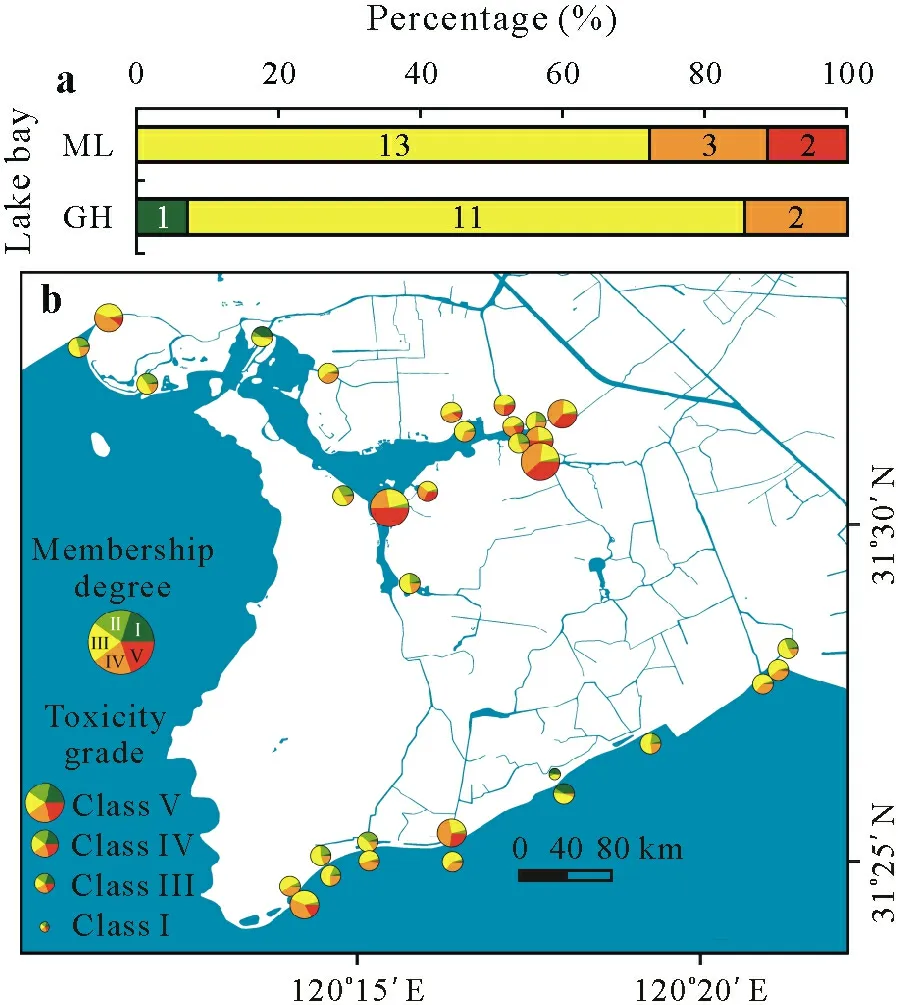
Fig.4 Percentage of each ecological toxicity grade(a)and membership degrees of different ecological toxicity grades in each class(b)for polycyclic aromatic hydrocarbons in the sediments from the Meiliang(ML)and Gonghu(GH)bays in northern Taihu Lake,China based on the synthetic fuzzy evaluation model.Numerical values within colored rectangles in a represent the numbers of sampling sites associated with each ecological toxicity grade.
Regarding the spatial pattern(Fig.4),in the ML bay,13 sites(72%)were at the acceptable ecological toxicity level(Class III),and 3 sites(17%)were moderately polluted(Class IV),whereas 2 sites(M9-1 and M11-2)were heavily polluted(Class V),accounting for 11% of the sites.The results suggest that the sediments in the ML bay are polluted to varying degrees,with Class III being dominant.Along the GH bay,only one site(7%)was affiliated with Class I(clean),eleven sites(79%)were slightly polluted(Class III),and the remaining two sites(14%)were moderately polluted(Class IV).Both areas were mainly slightly polluted by PAHs,meaning that the PAH concentrations at most sampling sites were within an acceptable range.Overall,more sampling sites were moderately or heavily polluted in the ML bay(5 sites)than in the GH bay(2 sites),and most of these sites(M7-1,M8-2,M9-1,and M11-2),along with the two sites affiliated with Class V,were concentrated in the east of the Wuli Lake.The PAHs in the sediments of the ML bay had a relatively high toxicity effect.Especially,the PAHs in eastern the Wuli Lake were expected to pose a threat to aquatic organisms.
The membership degree score was different among samples affiliated with different ecological toxicity levels(Fig.4).Membership degree scores of Classes I,II,and V at each site were low,especially the lowest score of membership degree of Class I from most samples was close to zero,except for M3-1,G5-1,and G5-2.High membership degree scores of Class V were detected in the east of the Wuli Lake in the ML bay(M6–M11),suggesting that the toxicity at these sampling sites was on the rise and needs to be paid more attention.However,the membership degree scores of Classes III andIV at each site were at a relatively high level,with the largest mean score of membership degree detected in Class III.Difference in membership degree score of Class III between these samples was slight,indicating that most sampling sites would maintain the status of acceptable adverse biological effects for a long period.
Identification of contamination sources
The PAHs emitted from different sources exhibited different monomer composition characteristics.The diagnostic ratios(i.e.,ratios of LPAHs/HPAHs,BaA/Chry,and IcdP/(IcdP+BghiP))were used to infer possible PAH sources in the sediments(Yunkeret al.,2002;Liuet al.,2017;Li Q Yet al.,2020).A detailed description of the diagnostic ratios is provided in Table SV(see Supplementary Material for Table SV).The characteristics of PAH molecular ratios for sediment samples are shown in Fig.5.Most samples(95%)presented the LPAHs/HPAHs ratio(0.09–0.34)less than 1,indicating that PAHs in the sediments were mainly derived from thermal combustion.This was also supported by a BaA/Chry ratio of 0.17–1.20,indicating that petroleum combustion were the main sources of PAHs in the sediments(Fig.5,Table SV).The IcdP/(IcdP+BghiP)ratio in all samples was greater than 0.20.In about 81%of the samples,this ratio was within the range from 0.20 to 0.50,suggesting that PAH levels in those sediments were primarily dependent on the combustion of petroleum.The remaining 19%of samples had IcdP/(IcdP+BghiP)ratio higher than 0.5,indicating an influence of coal and biomass combustion.In summary,the results confirmed pyrogenic sources as dominant sources of sedimentary PAHs in the study area.
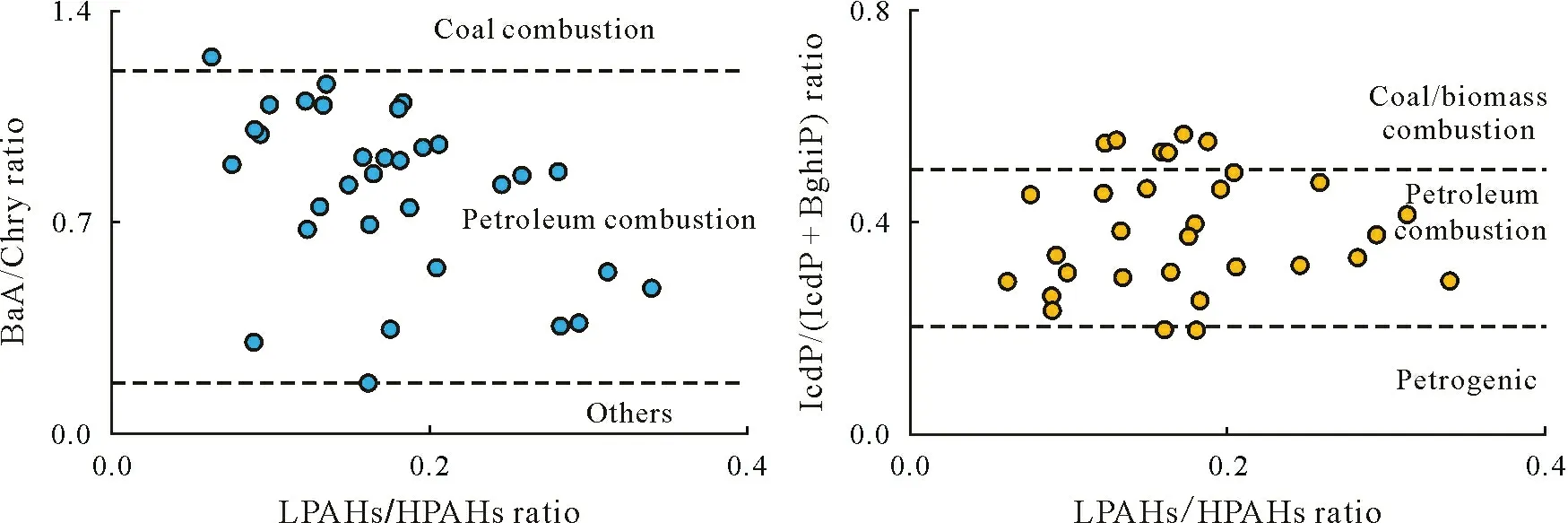
Fig.5 Possible polycyclic aromatic hydrocarbon(PAH)sources in the sediments from the Meiliang and Gonghu bays in northern Taihu lake,China inferred from diagnostic ratios of low-molecular-weight PAHs(LPAHs)/high-molecular-weight PAHs(HPAHs),benzo(a)anthracene(BaA)/chrysene(Chry),and indeno(1,2,3-cd)pyrene(IcdP)/(indeno(1,2,3-cd)pyrene(IcdP)+benzo(g,h,i)perylene(BghiP)).See Table SV(see Supplementary Material for Table SV)for detailed description of the horizontal dotted lines indicating the cut-offvalues for combustion sources and other sources.
However,the resolution of these diagnostic ratios was not sufficient to quantify each source of PAHs.In this respect,15 priority PAHs were employed in the PCA with varimax rotation to determine the distribution and apportionment of the possible sources(Taoet al.,2019)(Fig.6),with Flua not considered in this study because of its low detection rate(53%).The first two PCs,PC 1 and PC 2,explained 75.11%and 11.82%of the total variance among samples,respectively(Fig.6).The PC 1 strongly reflected the variations in Pyr,Chry,BbF,BaP,and IcdP,and had moderate loading for BaA and BghiP,which may be influenced by vehicle emission(Maet al.,2018;Caoet al.,2020).Pyrene can be used as a tracer of diesel combustion and gasoline engine emission(Hildemannet al.,1991;Maiet al.,2003),whereas BaA and Chry are mainly released by the combustion of natural gas(Harrisonet al.,1996).Benzo(b)fluoranthene is produced directly by vehicles(Guarieiroet al.,2014;Li Yet al.,2020),and BaP,IcdP,and BghiP are emitted by both diesel and gasoline engines(Larsen and Baker,2003;Zhenget al.,2017).The Taihu Lake basin is an important economic development center of the Yangtze River Delta.The 13th Five-Year Plan proposed to establish Wuxi City as a national comprehensive transportation hub,with the total number of vehicles increased by 154.12%in 2017 compared with that in 2000(Bureau of Statistics of Wuxi City,2000,2017).High traffic flow is an important factor leading to PAH accumulation in sediments.Additionally,natural gas consumption increased in the study area(from<8 to 598 m3cap−1)during 2000–2017(Bureau of Statistics of Wuxi City,2000,2017).Therefore,it was reasonable to assign PC 1 to vehicle emission and natural gas combustion.
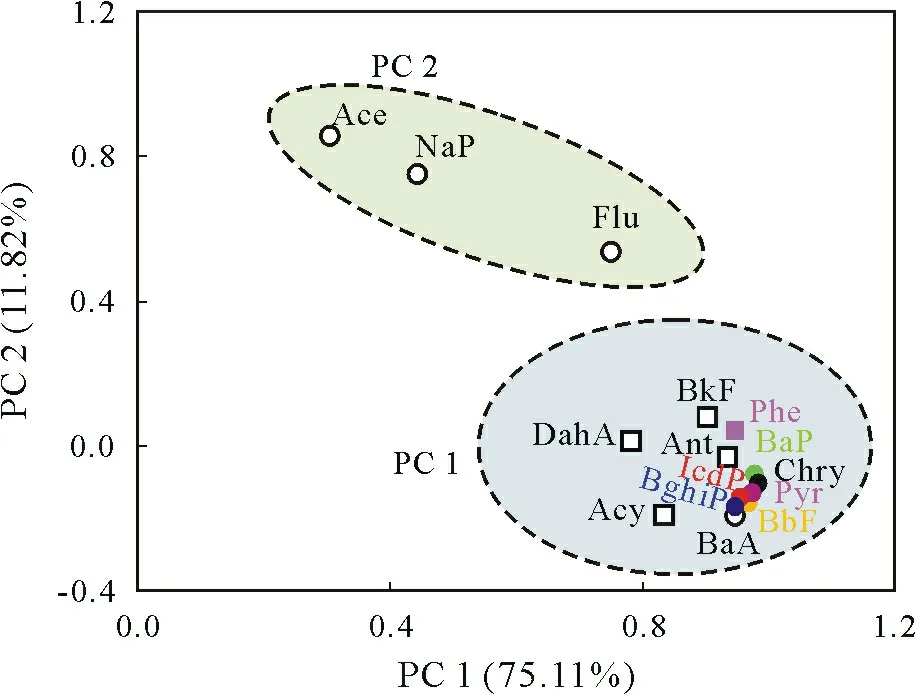
Fig.6 Principal component(PC)loadings for sediment samples.Nap=naphthalene;Acy=acenaphthylene;Ace=acenaphthene;Flu=fluorine;Phe=phenanthrene;Ant=anthracene;Flua=fluoranthene;Pyr=pyrene;BaA=benzo(a)anthracene;Chry=chrysene;BkF=benzo(k)fluoranthene;BbF=benzo(b)fluoranthene;BaP=benzo(a)pyrene;DahA=dibenzo(a,h)anthracene;IcdP=indeno(1,2,3-cd)pyrene;BghiP=benzo(g,h,i)perylene.
The PC 2 was characterized by high loading for NaP,Ace,and Flu.Naphthalene is associated with incomplete combustion of raw coal(Simciket al.,1999;Zhenget al.,2017).Acenaphthene and Flu represent the profile of coal combustion(Miguel and Pereira,1989;Zhenget al.,2017),whereas Ace can be a product derived from wood combustion(Maet al.,2018).However,Wuxi City has completely replaced the combustion of wood and straw with fossil fuels to satisfy energy demand for production and living since the 2000s.Consequently,the predominance of Ace and Flu in PC 2 may indicate a partial contribution of PAHs from coal combustion.The consumption of raw coal in Wuxi City is in a state of continuous growth,reaching 5.18 t cap−1in 2017,an increase of 120.22%compared with that in 2000(Bureau of Statistics of Wuxi City,2000,2017).
Eventually,we calculated the percentage contributions of these sources using the results of the MLR analysis.By performing a stepwise procedure,the MLR equation with standardized coefficients was used to estimate the mean contribution of each type of PAH source(Table II)(Larsen and Baker,2003;Taoet al.,2019).Vehicle emission and natural gas combustion contributed 81%,and coal combustion contributed 19%.A combination of the results drawn from the PCA-MLR with diagnostic ratios revealed that vehicle emission and natural gas combustion were the most significant contribution sources of PAHs,followed by coal combustion.

TABLE IIMultiple linear regression(MLR)analysis of polycyclic aromatic hydrocarbon concentrations(y)vs.derived principal components(PC 1 and PC 2)and statistical significance
CONCLUSIONS
In this study,the dammed lakeside city estuaries in the northern Taihu Lake were employed to investigate the distribution,sources,and behavior of PAHs in sediments.The PAH concentrations in the estuarine sediments of the Taihu Lake were higher than those of most remote lakes in China,but lower than those of some lakes abroad.The concentrations of PAHs in the estuarine sediments from the ML bay were lower than those in river sediments,with the opposite phenomenon in the GH bay,which was significantly affected by the presence of gates and dams.Total organic carbon in the sediments predominantly adsorbed LPAHs rather than HPAHs,and thus the high proportion of HPAHs(mean 85%)released from local pollution sources in high-temperature processes was less affected by organic matter.Approximately 97% of sampling sites were classified into Classes III–V(acceptable to high ecological toxicity)based on the fuzzy synthetic evaluation model,with high ecological toxicity in M9-1 and M11-2 of the ML bay.Source identification using diagnostic ratios and PCA-MLR indicated that PAHs in the sediment were mainly generated by vehicle emission and natural gas combustion(81%).
ACKNOWLEDGEMENT
This work was supported by the National Natural Science Foundation of China(No.41673107),the National Water Pollution Control and Treatment Science and Technology Major Project,China(No.2017ZX07203-005),and the Major Project of Jiangsu Provincial Department of Education,China(No.20KJA170001).
SUPPLEMENTARY MATERIAL
Supplementary material for this article can be found in the online version.
杂志排行
Pedosphere的其它文章
- Effect of indaziflam on microbial activity and nitrogen cycling processes in an orchard soil
- Spectral indices measured with proximal sensing using canopy reflectance sensor,chlorophyll meter and leaf color chart for in-season grain yield prediction of basmati rice
- Effect of Zn binding to phytate and humic substances on its uptake by wheat(Triticum durum L.)as affected by carbonates and Fe oxides
- Contribution of arbuscular mycorrhizal fungi and soil amendments to remediation of a heavy metal-contaminated soil using sweet sorghum
- Nitrogen slow-release behavior of oxamide granules in two different types of paddy soils
- Effective alleviation of Cd stress to microbial communities in mining reclamation soils by thiourea-modified biochar amendment
